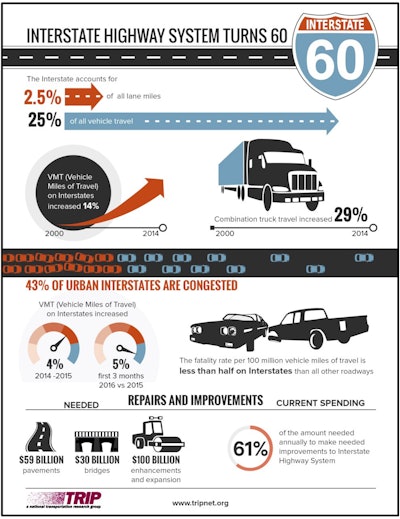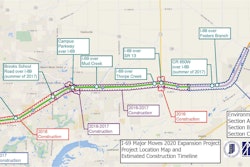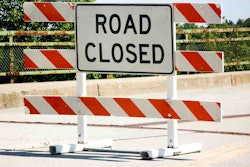The Road Improvement Program (TRIP) says the U.S. Interstate Highway System is showing its age as it turns 60 this month, suffering from high levels of congestion and too little funding to make repairs and updates.

TRIP says the report indicates 25 percent of U.S. vehicle travel occurs on the interstate system, yet it only represents 2.5 percent of the lane miles in the country.
“The system is increasingly congested, with truck travel growing at a rate twice that of overall Interstate travel,” the organization says. “And, while the nation’s Interstates tend to be in better condition than other roads and bridges, the aging system lacks the required funding for needed improvements and repairs.”
“Drivers are frustrated with the condition of the nation’s transportation system,” said Jill Ingrassia, AAA’s managing director of government relations and traffic safety advocacy. “While a record 36 million travelers plan to hit the road for Independence Day weekend, nearly 70 percent are concerned that roads and bridges are not in great driving condition. AAA urges lawmakers to keep their eye on the ball to identify a sustainable funding source to maintain and improve our Interstate system for the future.”
TRIP’s report highlights the level of congestion and pavement and bridge conditions of the Interstates by state. The organization found Hawaii had the highest percentage of Interstate pavement in poor and mediocre condition, at 51 percent. Rhode Island had the highest percentage of structurally deficient bridges on Interstates at 15 percent. California had the most congested urban Interstates, at 85 percent, and Wyoming had the most Interstate vehicle travel by combination trucks, at 33 percent. The state ranking the highest in travel increases on Interstates from 2000 to 2014 was Louisiana, with a 43 percent increase. A full list of these conditions for each state is available in the report’s Appendix.
There is a positive side to TRIP’s report. The Interstates’ design, by nature, has made them more than twice as safe to travel on compared to all other roadways, TRIP says, with a fatality rate of 0.54 per 100 million vehicle miles of travel on the Interstate system in 2014. For non-Interstate routes, that figure was 1.26. TRIP estimates the Interstate system saved 5,350 lives in 2014, “based on an estimate of the number of additional fatalities that would have occurred had Interstate traffic been carried by other major roadways, which often lack the safety features common to Interstate routes.”
But TRIP stresses the Interstate system needs many updates, citing the U.S. Department of Transportation’s estimate that the current backlog of improvements needed is $189 billion.
“The long-term vision that helped establish the current Interstate system 60 years ago is needed again today,” says TRIP Executive Director Will Wilkins. “In order to maintain personal and commercial mobility, transportation investment and a sustainable, long-term funding source for the federal surface transportation program must remain a priority.”
“The United States moves in large part thanks to the efforts of many elected officials, organizations and citizens whose shared foresight led to the construction of the national interstate system,” says Bud Wright, executive director of the American Association of State Highway and Transportation Officials. “Now, as we commemorate the 60th anniversary of the Interstate act, it’s clear that our investments in preserving the system are not keeping up even as our nation continues to grow.
TRIP periodically releases state reports on road conditions and costs to motorists. They are available at tripnet.org.













